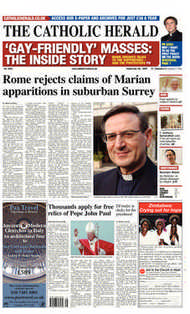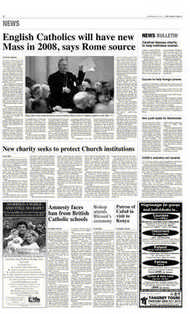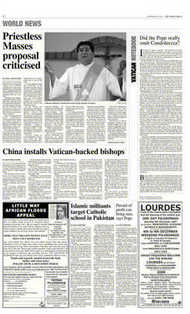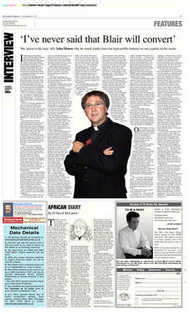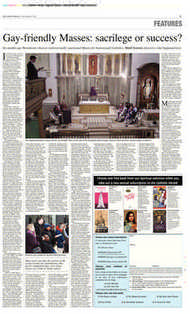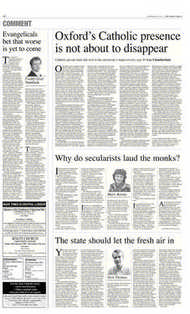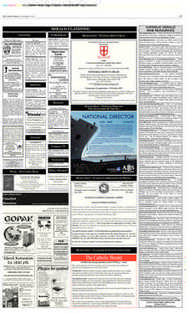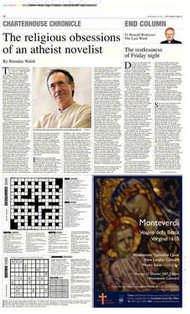Page 8, 28th September 2007
Page 8

Report an error
Noticed an error on this page?If you've noticed an error in this article please click here to report it.
Tags
Share
Related articles
Shrines To The Sacraments
Victorian Society Condemns Church Closures
First Choose Your Architect
The Lost Legacy Of 'middle' Scott
Beauty Is In The Eye Of The Needle
Bodley Can Help Us To Rediscover Beauty
No longer the Cinderella of the Victorian age
There is a reawakening of interest in Britain’s most beautiful Catholic churches, says Anthony Symondson SJ. But is it too late to save them?
Since the publication last year by English Heritage of A Glimpse of Heaven by Christopher Martin, magnificently illustrated with photographs by Alex Ramsay, there has been a sea-change in the recognition and appreciation of British Catholic churches. Long considered the Cinderella of the Gothic Revival, Catholic church architecture was unjustly seen to be inferior to the Anglican counterpart. Forty years ago I remember John Betjeman saying to me, while looking at photographs of Victorian churches, “Theirs are not as good as ours”: ours being Anglican churches. And the same attitude was frequently to be found among progressive Catholic architects of the time, determined to alter existing churches and build new ones in what was then considered to be a radically drastic liturgical style.
Disheartened by this dismissive attitude, priests and people became ashamed of their churches; but this also should be seen in context. It took a long time for the public at large to come to terms with Victorian church architecture and the majority of Catholic churches are Victorian. Several leading 20th-century architectural historians were Catholics, notably H S Goodhart-Rendel, Peter Anson, Brian Little and Michael Trappes-Lomax, the biographer of Pugin. In their books and articles they wrote about Catholic churches with understanding and perception. Goodhart-Rendel even went so far as to claim J F Bentley, the architect of Westminster Cathedral, as the greatest architect of the late Gothic Revival and considered his matchless church of the Holy Rood, Watford, to be “the most lovely church the 19th century gave to England”. Today Victorian architecture is accepted as one of the most creative periods of British history.
Of all building types churches are at present the most vulnerable. Declining congregations, demographic changes, fewer priests, failing religious orders are placing serious financial strain on dioceses and congregations to maintain existing churches. This is a problem the Church of England faced long ago. The Pastoral Measure was passed in 1968. By the end of 2000, 315 buildings were vested in the Churches Conservation Trust, 864 were adapted to alternative use, 337 were demolished. Nothing like these figures have been reached by the Catholic Church but there is a slow erosion of the Church’s building stock and controversial redundancies lie on the horizon.
In 2006 English Heritage launched the Inspired campaign to protect British church architecture. New research showed that, although congregations of all denominations managed to raise £67m each year, the annual amount actually needed for repairs exceeded £185m. That leaves a staggering £118m annual shortfall which English Heritage and other grant-making bodies simply cannot fill and which they cannot realistically expect the Government to pay for. Solutions are being sought, including revised lists, providing advisers to support local congregations, creating maintenance grants and maintaining the joint English Heritage/Heritage Lottery Fund repair grants scheme.
There are 2,765 Catholic parish churches and 700 other Catholic churches and chapels in England open to the public, of which 625 (18 per cent) are listed buildings. For many years English Heritage has worked to include Catholic churches and Nonconformist chapels within their grant-making procedures. The lion’s share of grants go to the Established Church for the reason that it has the majority of medieval buildings. Between 2005 and 2007, 22 Catholic churches applied for grantaid, of which nine were assisted. This is a fair aggregate and included churches that covered a broad spread of the country, including town and country parishes.
The grants covered essential repairs but there have been cases which illustrate disparities. One of the most significant was St Raphael’s, Kingston-on-Thames, a church of serious architectural distinction, built in 1846 of stone in the Italianate-Early Christian style as a private chapel, designed by Charles Parker, the architect of Hoare’s Bank. It is an effective Classical rejoinder to Pugin and one of the rarest and least spoilt Catholic churches in the country. Surprisingly, it was omitted from A Glimpse of Heaven. Supported by the Archbishop of Southwark, Fr Vincent Flynn, a vigorous young parish priest, wants to repair it after years of neglect, restore the interior decoration and adapt the delightful Classical ancillary wings flanking the church.
English Heritage encouraged an application, helped with advice and the completion of the complicated forms, but refused a grant on a technicality. This was reinforced by the observation that Kingston was an affluent district which had greater prospects of fund-raising than poorer parishes. But this ignored the fact that in all but rare instances the majority of Catholic congregations are poorer than their Anglican counterparts and they don’t have the same breadth of appeal. Fr Flynn is determined to press on, and his approach to the church in terms of repair and conservation is exemplary. I hope that, in time, English Heritage will reverse its decision.
During the last 40 years damage has been done to many Catholic churches. In recent years this problem has quietened and the Church now regards its architectural heritage with greater seriousness and responsibility than in the past. A British problem was the ecclesiastical exemption from building controls. Unlike on the Continent, the state does not control what happens to churches nor maintains them. Listed building consent has to be obtained and the creation of the Catholic diocesan Historic Churches Committees offers not only higher standards of repair and suitability but also control in what is done to them. At first, some parish priests resented these developments and, although the new system seems to some like shutting the stable door after the horse has bolted, the protection that the system offers is being accepted.
This does not mean that mistakes are not made and private interests served. Committees composed of groups of dioceses, like the Southern Historic Churches Committee, which includes Arundel and Brighton, Plymouth, Portsmouth and Southwark, are able to apply a greater degree of objectivity. Individual diocesan committees offer more loopholes and local or diocesan pressure is more likely to Another problem is the architectural education of the clergy. There has long been a minority of priests who are interested in architecture and have the right approach to the buildings in their charge. English Heritage believes that looking after historic buildings is not necessarily part of a priest’s vocation and recognises that he is not trained to do it. But I don’t think that this should be taken as a permanent assumption. One solution is better instruction in the seminaries and the provision of courses on architectural history and building maintenance. This should not be seen as an exercise in dilettantism but a pastoral and liturgical necessity. The further we get away from the past the more difficult it is to understand what lies around us. Sound architectural knowledge will prevent many blunders and deepen an understanding of what churches are, why they should be looked after, and ensure that they are used well.
These and other subjects are being addressed by the Friends of Westminster Cathedral. A day seminar, entitled “A Glimpse of Heaven”, is being organised in conjunction with English Heritage on Saturday, October 13 in the cathedral hall. In the morning speakers will include Richard Halsey and Fr Peter Newby. The afternoon will be spent on architectural history, led by Christopher Martin. Other speakers are to be included in what promises to be a valuable and instructive event. This provides an opportunity to learn more about a subject of increasing interest and concern and deserves to be well supported.
The seminar lasts from 10.45 am-4 pm. Cost £45, including lunch and refreshments. Further details: 0207 798 9059 or send a cheque and SAE to The Friend’s Office, 42 Francis Street, London, SW1P 1QW
blog comments powered by Disqus


